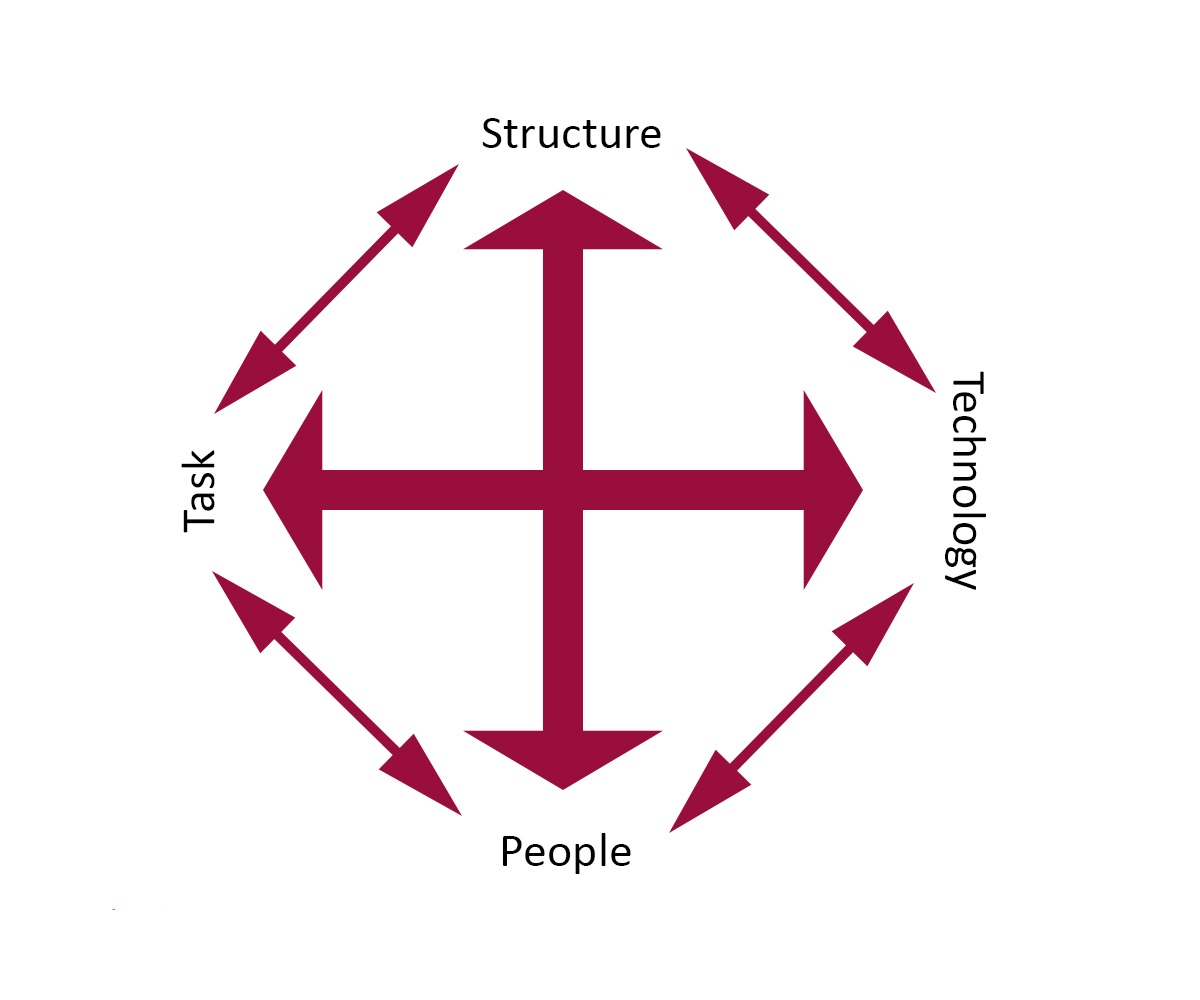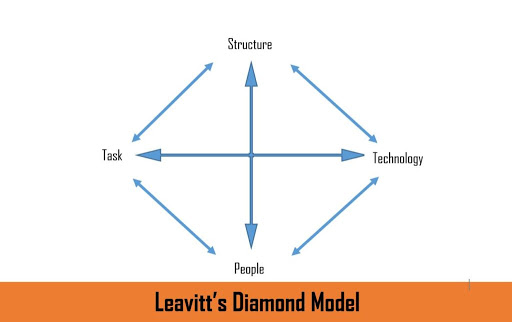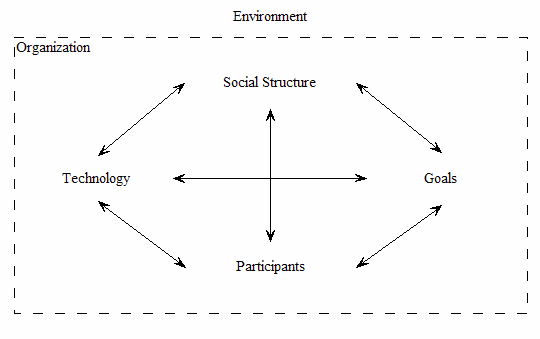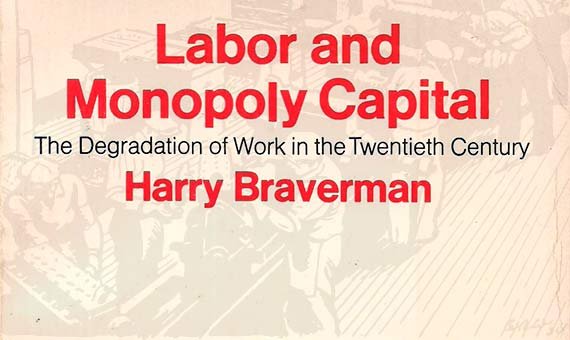Leavitt Model of Organizational Change | Leavitt Diamond Model
What is Leavitt Diamond Model?
Harold J. Leavitt developed Levitz Diamond Model in 1965 to understand the interplay of four key elements: the task, structure, people, and technology. Today, it is one of the most widely used models to get an overview of how organizational change will be most effective.
According to Leavitt Diamond Model, the best way is to split the organization into four components. The four components form Leavitt’s Diamond model, and its key principle is that if one variable of organizational change is changed, it does affect other variables.
In other words, if people get changed, then it will affect structure, tasks, and technology, and if there are changes in technology, then it will have implications for all other elements, which are people, structure, and tasks.

The four components are;
- Tasks, also sometimes called goals,
- Structure
- Technology
- People are also sometimes called employees.
Any type of change or redesign is done in one component will affect the other three components. According to Leavitt Diamond Model, before you implement change in any one of the four components, you should evaluate the effect on the other three components.
These four components are distinct from each other, but at the same time, there is an interaction between them. The four components make up the entire organization. To implement change successfully, you need to find the right balance between all of them.
The surroundings can, of course, also affect the organization and thereby the individual components.
Tasks
In most cases, these are about the goods and services that an organization sells. There are exceptions. Public organizations are not dependent on selling goods and services. Their task is to deliver goods and services to the people. For that purpose, we pay our Taxes.
Structure
This is about the formal patterns of the organization.
💥🎁 New Year & Easter Deals On Amazon !
Don't miss out on the best discounts and top-rated products available right now!
🛒 Shop Now and Save Big Today!*As an Amazon Associate, I earn from qualifying purchases.
- How is the organization of Labor?
- What is the decision-making structure?
- The COO (Chief operations officer) must decide versus the CFO’s decisions, the chief financial officer, has to make.
- What are the communication patterns? Are you allowed to see all documents, or are there restrictions depending on your company’s position?
Technology
This is actually a slightly misleading term. It’s beyond information technology.
It also encompasses buildings, refurbishment of premises, the machinery that is in the organization, on the associate with workflows.
You could say that it is about both hardware and software, as it also deals with I t programs, which today are everywhere.
People Also Called Employees.
Overall, it is because people are associated with an organization to such a high degree that they become part of the organization’s culture.
Factors Affecting Organizations
An organization is affected by many factors that occur in the organization as well as outside and into the organization.
But whether they come from inside or outside, the organization is affected. It would be best to imagine the organization as a living organism that continuously adapts to both internal changes and external influences.
Examples of Factors
These are some examples that you probably have heard of, and they will be placed in Leavitt’s Diamond Model,
New It System
A new IT system such as a new logistics IT program.
- It is placed in the component technology;
- It may affect the component people.
- The employees in the Department of Logistics need to be trained to handle the new program.
Changing Legislation.
This is clearly placed in the surrounding world.
- New speed limits do not affect the organization, but if it’s new rules about more extended maternity leave, then it affects the component people.
- But it will also influence the component structure.
- The organization will have to ensure that all employees are placed so that all tasks are completed.
Restructuring of The Organizations
Restructuring of the organization must, of course, be placed in the component structure.
💥🎁 New Year & Easter Deals On Amazon !
Don't miss out on the best discounts and top-rated products available right now!
🛒 Shop Now and Save Big Today!*As an Amazon Associate, I earn from qualifying purchases.
- It affects component people as employees are moved around the organization.
Laying off an Employee.
This is undoubtedly in the component people, but then it becomes the component structure.
- Tasks up to be distributed amongst fewer employees and then again,
- We are back in the component people. The remaining employees have to work harder.
New Rules for Paying VAT
This comes from the surrounding world.
- At first, it affects the component tasks, which, of course, change.
- This affects the component people since the employees must familiarize themselves with the new rules.
- It will probably affect the component’s structure as there will be new work processes.
The Employees Level of Education.
This is part of the component people.
- The level of education affects both the component tasks and the component structure.
- The higher the education level of the employees, the more complicated tasks and responsibilities we can give to the employees
- This impacts how decisions should be made, which is determined in the component structure.
The Employee’s Personality.
Here we are talking just like in the previous example about the component people.
- It is not just the employees’ level of education that is essential for the distribution of responsibility and authority to employees.
- The employee’s personality certainly influences the design of the component’s structure and tasks.
- There is a big difference whether we are dealing with independent employees who want to work or with employees who only go to work to make money as easily as possible,
The Buildings and Their Interior.
Here we begin in the component technology.
- It will quickly affect the component people since a new arrangement off desks affects the employees,
- The components structure will probably also be affected as new buildings, and interior design will require new communication and organizational structure.
New Company Cars
Again, we begin with the component technology.
- It quickly affects the component people because those receiving the new company cars hopefully will be more satisfied.
- The problem is just that those who do not get a new car may be a bit disappointed. So, the manager is going to work a lot more with the employees in the component people when purchasing new cars than with the component technology.
Application of Leavitt Model
You can benefit from using the Leavitt model. Imagine you are a leader who must make your organization work optimally.
This requires that you continually make adjustments since changes always occur somewhere in the organization.
These can come from surroundings as well as from within the organization.
It would help if you imagined that you are standing in the middle of the model on that you are an agent of change. You must balance the organization.
💥🎁 New Year & Easter Deals On Amazon !
Don't miss out on the best discounts and top-rated products available right now!
🛒 Shop Now and Save Big Today!*As an Amazon Associate, I earn from qualifying purchases.
You must take care of the components’ changes and how this affects the other components.

Advantages of Leavitts Diamond Model
- Organizations are inter-connected structures, where changing one part can impact many others. Therefore, to implement change successfully, you have to adopt an integrated change strategy. The idea of Leavitt’s Diamond can help you build this integrated strategy.
- Change cannot be implemented in isolation, as it can have many knock-on impacts throughout an organization, both expected and unexpected.
- It provides an easy model for understanding the interdependency between four key variables: people, task, structure, and technology.
- Using this framework, you can analyze the impact of the proposed change and use your implementation strategy results.
Disadvantages/Criticism of Leavitt Diamond Model
- The model does not take into account that several changes can take place at the same time.
- There is no priority given to the changes in their order of importance.
However, it is recommended that you use the model so that you don’t overlook a component.

